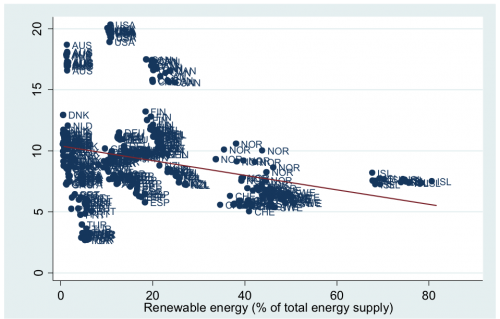Sustainability Concerns and Renewable Energy Use
At the World Economic Forum in Davos, Switzerland, the World Bank Group’s President, Jim Yong Kim, declared 2014 “the year to take action on climate change.” During the forum, many political leaders and businesses from around the world expressed sustainability concerns and recognized the need for switching from relying primarily on finite non-renewable sources to a more diversified energy mix, typically consisting of a combination of fossil fuels, nuclear energy, and renewables. Both economic and environmental reasons support the move toward an energy mix. First, concerns about the finite nature of conventional energy sources, such as oil and gas, create an economic incentive to find new ways for energy generation. Second, increasing understanding of climate change and its underlying causes—mainly greenhouse gas (GHG) emissions—creates urgency for action to mitigate the negative impacts related to carbon-emitting fuels.
With global energy demand increasing and the dominance of carbon-based production decreasing, policy measures including shifts in the energy mix can reduce the levels of harmful emissions. Renewable energy (RE) policies are frequently justified by their proponents as a means to improve both economic and environmental conditions. When speaking at Georgetown University in June 2013, President Obama referred to the need to “deal with climate change in a way that promotes jobs and growth.” Policymakers commonly presume that promoting RE production accomplishes both goals by creating jobs in the clean energy sector and reducing GHG emissions. To test these assumptions, many authors have analyzed the connection between economic growth and RE, but relatively few have studied the link between environmental outcomes and RE policies. In other words, does investment in RE actually benefit the environment?
Empirical Approaches Evaluating the Effects of RE
A substantial part of the literature on RE is devoted to the analysis of the drivers of RE use, including economic growth, the level of GHG emissions, and energy policies. This research expands upon existing work that discusses environmental impacts of RE. It further explores the association between clean energy use and environmental outcomes by focusing on the relationship between carbon dioxide (CO2) emissions and RE production.
In contrast to many previous studies of RE, which examine RE growth in response to the levels of GHG, I use CO2 emissions as the dependent variable and the share of renewable energy as the explanatory variable. I chose CO2 emissions as an indicator of environmental conditions in order to find out if RE policy implementation has any effect on levels of CO2. This approach was used to assess the relationship between RE supply and CO2 emissions in 23 member countries of the Organization for Economic Co-operation and Development (OECD) between 1992 and 2007. The data were obtained from the World Bank and the OECD.
In recent decades, many OECD countries modified their energy mix to meet their energy needs and to improve environmental conditions. A study by Chiu & Chang (2008) showed that OECD energy portfolios containing at least 8.4 percent of RE are likely to lessen the negative effects of GHG and climate change. Figure 1 shows a weak negative association between CO2 emissions per capita and the share of RE supply over time. Since fossil fuels are still the predominant energy-producing source, the hypothesis tested was that the share of RE in the energy mix is not sufficient to mitigate the environmental externalities from fossil fuel combustion, while controlling for other factors.
Carbon dioxide emissions and Renewable energy supply in OECD (1992-2007)

My empirical findings indicate that RE implementation in OECD countries has a small, but statistically significant effect on reducing CO2 emissions. This shows that RE as part of the energy mix has the potential to improve environmental sustainability, but its current impacts on harmful emissions are minimal: a one-percentage point increase in RE supply is expected to reduce CO2 emissions by 112 kg per capita. In comparison, the average CO2 emissions between 1992 and 2007 were 14,000 kg per capita per year. So even assuming that countries were able to achieve this one-percentage point increase in RE supply on an annual basis, the resulting CO2 reduction would represent only 0.8 percent of the average annual CO2 emissions per capita. This carbon reduction rate is unlikely to be sufficient to achieve important levels set by the United Nations’ Kyoto Protocol framework on climate change, and additional means of reducing CO2 emissions will be necessary.
Moreover, my paper finds a persistence effect with respect to CO2 emissions: the previous year’s CO2 emissions are a strong predictor of CO2 emissions in the current year. This means that increase in GHG today results in even higher levels of harmful emissions tomorrow. I show that a 1,000 kg per capita increase in CO2 emissions is expected to increase CO2 emissions by 466 kg per capita in the next year. Therefore, an urgent policy response from the global community is needed in order to break the cycle of ever-increasing pollution.
These findings suggest that pursuing policies designed to increase the relative use of RE can be expected to have environmental benefits, but more ambitious measures are needed to achieve important reduction in GHG levels necessary to halt climate change. Economic and technological constraints make it currently unfeasible to fully transition to RE sources. Nevertheless, related policies directed at enhancing energy efficiency, such as, lowering costs of market entry for new clean technologies and suppliers, diversifying the energy mix by a gradual decrease of technological dependency on fossil fuels, and enhancing public awareness about the negative consequences of climate change, may be viable options to promote the reduction of CO2 emissions.
Ekaterina (Katya) Glandon holds a Master’s Degree in Public Policy from Georgetown University’s McCourt School of Public Policy. She currently works at a major international law firm in Washington, D.C. Her prior experience also includes a trade association and multinational corporations in the technology and food production sectors.
